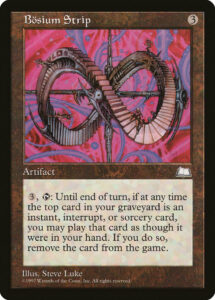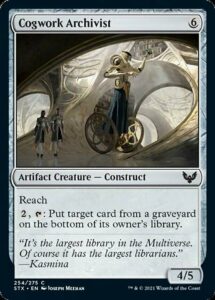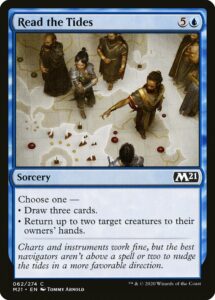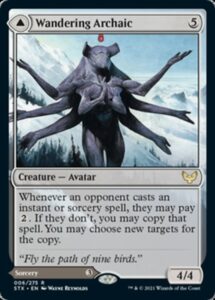Strixhaven introduces a novel mechanic in Learn with some truly spectacular play patterns. The Limited format features greedy multicolor decks, which is something I have quite the affinity for (though greedy Temur decks were arguably also the best deck in Kaldheim). But my favorite design in the set is much humbler. It slots into greedy Lesson decks, but is by no means a necessary inclusion. It has a rich history and is one of the most balanced executions of its effect.
Today, let’s consider all the work that made Cogwork Archivist what it is.
Looping the Dream
Since the dawn of Magic, control players have sought to win the game by playing as few win conditions as necessary. You could load up on countermagic and removal and win with a single copy of Serra Angel. You could Millstone your opponent to death. Or, you could do the slowest possible thing and ensure that your opponent decks well before you do. This is the promise that Feldon’s Cane made and was eventually restricted in Vintage for keeping.
We’ve seen this play pattern crop up fairly often in Limited. Innistrad’s Spider Spawning deck could (but didn’t need to) loop an empty deck via Memory’s Journey + Runic Repetition. In M14, Elixir of Immortality was one of the best uncommons due to the set’s weak aggression and preponderance of removal and card advantage. There was Reito Lantern in Conspiracy and Epitaph Golem in Shadows over Innistrad. You could pair two copies of Gaea’s Blessings in Dominaria or Clear the Minds in Ravnica Allegiance.
It’s incredibly exciting to live on the razor’s edge—Mulching away your library, then manipulating your graveyard to ensure that you not only avoid decking, but always draw the exact card you need. Library-looping decks tend to increase the range of playable cards, since they rely on effects most decks have no interest in. They can also be absolutely miserable to play against. They’re the Limited version of Dredge—your opponent flops their deck face up and starts playing a completely different game that’s nigh-impossible to interact with.
Cogwork Archivist plays in this vein, but it’s a much more balanced looping effect. Elixir of Immortality is all but impossible to interact with and shuffles so that you might draw good cards immediately. Epitaph Golem is one of the few looping effects that dies to creature removal, but it doesn’t take much time or mana to go from a depleted deck to a perfectly manipulated pile of the best cards in your deck.
Cogwork Archivist, on the other hand, is slow and steady. If you’re living on the razor’s edge of a tiny deck, it can’t un-thin your deck. If it dies, your deck goes right back to how small it was before. And if you’re not on the razor’s edge, well, it doesn’t really do anything (at least, not for a long while). Each activation requires mana, unlike Junktroller, so you have to create opportunities to refill your deck (or attack your opponent’s graveyard) rather than constantly do so. Those are solid debuffs (and improvements on) the generally uninteractive looping spells we usually see.
Context is Key
Cogwork Archivist isn’t laser-focused on enabling an archetype. Instead, it’s a versatile tool that doesn’t nothing particularly well, but does many things acceptable well. Its stats are balanced—big enough to stop most non-Fractal attackers yet expensive enough that you’re overpaying for a big blocker. It’s templated to hit either player’s graveyard. That’s a bit odd, since Strixhaven only has a few graveyard synergies (and rather annoying in Arena, since the program defaults to targeting your opponent’s graveyard) and because Magic has been cutting down on flexible abilities that add clicks; but it provides welcome lenticular design to a relatively simple card.
And once we look at the greater format, we see all sorts of little interactions that bolster Cogwork Archivist‘s effectiveness or make its usage a little bit more meaningful. You can combine it with Kelpie Guide to actually refill your deck. You can dig to the bottom of your deck with Quandrix Appentice or use a late Field Trip to shuffle. You are rewarded for scrying with Quandrix Campus after activating the Archivist (since you push a bottomed card up by scrying to the bottom) and recognizing the few times it’s better to activate Archivist instead of your Campus when mana is tight. You can use it with Lorehold cards to constantly enable leaves-graveyard shenanigans (admittedly, I’ve never seen this in action—though I’ve not seen many Lorehold decks function well).
Cogwork Archivist has a surprisingly nuanced array of play patterns. It does so while avoiding the frustration of most effective looping cards. It communicates a bit of worldbuilding—Strixhaven’s massive library housing the Mystic Archive. Frankly, I only have one major critique, and we’ve talked plenty about the problems with Reach on creatures that don’t obviously have reach. (Yes, players should read cards and will make mistakes when they don’t. But if enough players consistently and repeatedly make the same mistake, the fault is with the game designers failing to accommodate human nature, not the players.)
And that’s Cogwork Archivist in a nutshell—a neat design that draws a line all the way back to Antiquities.
Zachary Barash is a New York City-based game designer and the commissioner of Team Draft League. He designs for Kingdom Death: Monster, has a Game Design MFA from the NYU Game Center, and does freelance game design. When the stars align, he streams Magic (but the stars align way less often than he’d like).





